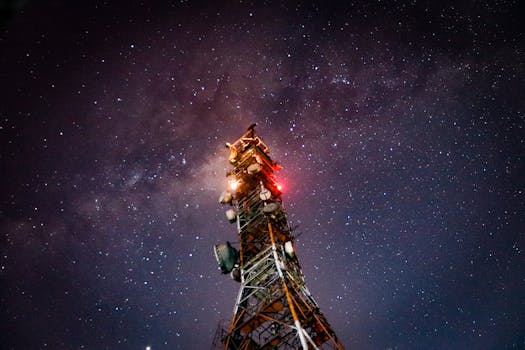MEO Satellites: Revolutionizing Global Communication with Medium Earth Orbit Technology

MEO satellites, or Medium Earth Orbit satellites, are a type of satellite that orbits the Earth at an altitude of around 2,000 to 36,000 kilometers. This is significantly lower than the Geostationary Earth Orbit (GEO) satellites, which orbit at an altitude of around 36,000 kilometers. The lower altitude of MEO satellites allows for faster and more reliable communication, making them an attractive option for a wide range of applications, including telecommunications, navigation, and Earth observation.
MEO satellites have several advantages over traditional GEO satellites. One of the main benefits is the reduced latency, which is the time it takes for a signal to travel from the Earth to the satellite and back again. With MEO satellites, this latency is significantly reduced, allowing for faster and more responsive communication. This makes MEO satellites ideal for applications that require real-time communication, such as video conferencing, online gaming, and financial transactions.
Another advantage of MEO satellites is their ability to provide global coverage with a smaller number of satellites. Because MEO satellites are closer to the Earth, they have a wider field of view, allowing them to cover a larger area with a single satellite. This reduces the number of satellites needed to provide global coverage, making MEO satellite constellations more cost-effective and efficient.
MEO satellites are also more resistant to interference and jamming than traditional GEO satellites. Because they are closer to the Earth, MEO satellites have a stronger signal, making them more difficult to interfere with. This makes MEO satellites a more secure option for sensitive applications, such as military communication and financial transactions.
Applications of MEO Satellites
MEO satellites have a wide range of applications, including telecommunications, navigation, Earth observation, and scientific research. In the telecommunications sector, MEO satellites are used to provide broadband internet access, mobile phone coverage, and other communication services. They are particularly useful in remote and underserved areas, where traditional communication infrastructure is lacking.
In the navigation sector, MEO satellites are used to provide location information and timing signals. They are used in a wide range of applications, including aviation, maritime, and land transportation. MEO satellites are also used in Earth observation, providing high-resolution images of the Earth’s surface and atmosphere. This data is used in a wide range of applications, including weather forecasting, climate monitoring, and natural resource management.
Challenges and Limitations of MEO Satellites
Despite the many advantages of MEO satellites, there are also some challenges and limitations to their use. One of the main challenges is the high cost of launching and operating a MEO satellite constellation. Because MEO satellites are closer to the Earth, they require more fuel to maintain their orbit, which increases their operational costs.
Another challenge is the limited lifespan of MEO satellites. Because they are closer to the Earth, MEO satellites are more susceptible to radiation and other forms of interference, which can reduce their lifespan. This means that MEO satellites need to be replaced more frequently, which increases their overall cost.
Conclusion
In conclusion, MEO satellites are a game-changer in the world of satellite communication. Their faster and more reliable connections, global coverage, and resistance to interference make them an attractive option for a wide range of applications. While there are some challenges and limitations to their use, the benefits of MEO satellites far outweigh the costs. As the demand for global connectivity continues to grow, MEO satellites are likely to play an increasingly important role in meeting this demand.
MEO satellites are revolutionizing the way we communicate globally, and their impact will be felt for years to come. With their ability to provide fast and reliable connections, MEO satellites are transforming the way we live, work, and interact with each other. Whether it’s providing broadband internet access to remote communities, enabling real-time communication for businesses, or supporting critical infrastructure for governments, MEO satellites are playing a vital role in shaping the future of global communication.
As the technology continues to evolve, we can expect to see even more innovative applications of MEO satellites. From providing connectivity for IoT devices to supporting the development of smart cities, MEO satellites are poised to play a key role in shaping the future of our connected world. With their unique combination of speed, reliability, and global coverage, MEO satellites are an essential component of the modern communication landscape.
The use of MEO satellites is not limited to any particular region or country. They are a global phenomenon, with the potential to connect people and communities all around the world. Whether it’s providing communication services to remote villages or supporting international business operations, MEO satellites are a vital part of the global communication infrastructure.
In addition to their practical applications, MEO satellites also have the potential to drive economic growth and development. By providing fast and reliable communication services, MEO satellites can help to stimulate economic activity, create jobs, and improve living standards. They can also help to bridge the digital divide, providing access to information and communication services for marginalized and underserved communities.
Furthermore, MEO satellites can also play a critical role in supporting disaster response and recovery efforts. In the aftermath of a natural disaster, MEO satellites can provide critical communication services, helping to coordinate relief efforts and provide vital information to affected communities. They can also help to support the recovery process, providing access to information and communication services that are essential for rebuilding and revitalizing affected areas.
In terms of their technical specifications, MEO satellites typically operate in the frequency range of 1-40 GHz, with a transmission power of up to 100 watts. They have a mass range of 100-1000 kg and a payload capacity of up to 1000 kg. MEO satellites also have a high-gain antenna, which allows them to transmit and receive signals with high accuracy and reliability.
Overall, MEO satellites are a powerful tool for global communication, with a wide range of applications and benefits. Their ability to provide fast and reliable connections, global coverage, and resistance to interference makes them an attractive option for a wide range of users, from individuals and businesses to governments and organizations. As the demand for global connectivity continues to grow, MEO satellites are likely to play an increasingly important role in meeting this demand and shaping the future of global communication.

